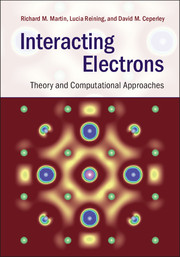Book contents
- Frontmatter
- Dedication
- Contents
- Preface
- Acknowledgments
- Notation
- Part I Interacting electrons: beyond the independent-particle picture
- Part II Foundations of theory for many-body systems
- Part III Many-body Green's function methods
- Part IV Stochastic methods
- 22 Introduction to stochastic methods
- 23 Variational Monte Carlo
- 24 Projector quantum Monte Carlo
- 25 Path-integral Monte Carlo
- 26 Concluding remarks
- Part V Appendices
- References
- Index
23 - Variational Monte Carlo
from Part IV - Stochastic methods
Published online by Cambridge University Press: 05 June 2016
- Frontmatter
- Dedication
- Contents
- Preface
- Acknowledgments
- Notation
- Part I Interacting electrons: beyond the independent-particle picture
- Part II Foundations of theory for many-body systems
- Part III Many-body Green's function methods
- Part IV Stochastic methods
- 22 Introduction to stochastic methods
- 23 Variational Monte Carlo
- 24 Projector quantum Monte Carlo
- 25 Path-integral Monte Carlo
- 26 Concluding remarks
- Part V Appendices
- References
- Index
Summary
Since the form of PN is the same as that occurring in the statistical mechanics of the classical gas (replace f2(rij) by exp[-V(rij/kT]), we can use the same integration techniques that are used in the classical problem.
W. L. McMillan, 1965Summary
Building on the random walk methods developed in the previous chapter, we show how to compute properties of many-body trial wavefunctions using a random walk. This method, called variational Monte Carlo, is the simplest stochastic quantum many-body technique. Whereas mean-field methods are usually limited to single determinants, variational Monte Carlo can treat any correlated trial function, as long as its values are computable. We discuss how to optimize such trial wavefunctions, how to compute their momentum distribution, how to use non-local pseudopotentials, how to compute excited states, and how to correct for the finite size of the simulation cell.
Deterministic quantum methods have difficulties. For example, the Hartree–Fock method assumes the wavefunction is a single Slater determinant, neglecting correlation. If one expands as a sum of determinants, it is very difficult to have the results size-consistent since the number of determinants needed will grow exponentially with the system size. As we have seen, the DMFT method introduced in Ch. 16 assumes locality. In Ch. 6 we discussed general properties of many-body wavefunctions. Using Monte Carlo methods, we can directly incorporate correlation into a wavefunction, without having to make any further approximations other than the form of the correlation factors. In many cases the energy and other properties are very close to the exact results. Some of the usual restrictions on the form of the many-body wavefunction are not an issue in variational Monte Carlo. The most important generalization of the HF wavefunction is to put correlation directly into the wavefunction via the “Jastrow” factor. At next order, one can use the “backflow” wavefunction, in which correlation is also built into the determinant.
The variational Monte Carlo method (VMC) was first used by McMillan [44] to calculate the ground-state properties of superfluid 4He. One of the key problems at that time was whether the observed superfluid properties were a consequence of Bose condensation.
- Type
- Chapter
- Information
- Interacting ElectronsTheory and Computational Approaches, pp. 590 - 608Publisher: Cambridge University PressPrint publication year: 2016



